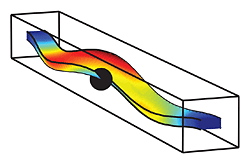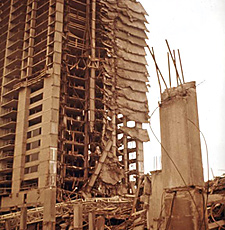| March 16, 2007

[NIST Tech Beat Search] [Credits] [NIST Tech Beat Archives] [Media Contacts] [Subscription Information]

James Turner Named as NIST Deputy Director
National Institute of Standards and Technology (NIST) Director William Jeffrey today announced the selection of James M. Turner to be NIST Deputy Director. Turner will begin work at NIST on April 16th.
As Deputy Director of NIST, Turner will assist in setting the strategic direction of the U.S. Commerce Department agency responsible for promoting U.S. innovation and industrial competitiveness by advancing measurement science, standards, and technology.
Turner, a physicist, currently is an Assistant Deputy Administrator in the U.S. Department of Energy (DOE) managing the National Nuclear Security Administration's Office of Nuclear Risk Reduction. His current duty is to oversee construction projects in Russia associated with the permanent shutdown of their last three nuclear weapons-grade plutonium-production reactors. The office also is charged with working with foreign governments and international agencies such as the International Atomic Energy Agency to develop policies and procedures to deal with nuclear emergencies.
Prior to that assignment, Turner held several senior management posts at DOE concerned with nuclear weapons safety and assisting the former Soviet republics in securing their nuclear weapons after the fall of the Soviet Union. He also headed the Department's Oakland Operations Office for six years. He holds a Ph.D. degree in physics from the Massachusetts Institute of Technology and a Bachelor's degree in Physics from Johns Hopkins University, and taught for five years as an Associate Professor of Physics and Engineering at Morehouse College.
Among other honors, he has received the U.S. Government Presidential Rank Award for Meritorious Service, three times received the U.S. Department of Energy Exceptional Service Award, and the Secretary of Energy Gold Award. A native of Washington, he is married, has five children, and one grandchild.
Media Contact: Michael E. Newman, michael.newman@nist.gov, (301) 975-3025 

New JILA Apparatus Measures Fast Nanoscale Motions
 |
This slow-motion simulation of the JILA nanoscale motion detector shows the wiggling of a floppy metal beam, just 100 nanometers thick, as it is struck by an electric current at the dot. Red indicates the greatest change in position from the rest state.
Credit: K. Lehnert/JILA
View hi-resolution image
View .avi movie |
A new nanoscale apparatus developed at JILA—a tiny gold beam whose 40 million vibrations per second are measured by hopping electrons—offers the potential for a 500-fold increase in the speed of scanning tunneling microscopes (STM), perhaps paving the way for scientists to watch atoms vibrate in high definition in real time.
The new device measures the wiggling of the beam, or, more precisely, the space between it and an electrically conducting point just a single atom wide, based on the speed of electrons “tunneling” across the gap. The work is the first use of an “atomic point contact,” the business end of an STM, to sense a nanomechanical device oscillating at its “resonant” frequency, where it naturally vibrates like a tuning fork. JILA is a joint venture of the National Institute of Standards and Technology (NIST) and the University of Colorado at Boulder.
Although the JILA technique, described in the March 2 issue of Physical Review Letters,* is not necessarily as precise as more complex and much colder methods of measuring very fast motions of ultra-small devices, it incorporates several innovative attributes. These include the ability to minimize unwanted random electronic “noise” as well as to measure the random shaking of the beam caused by back-action or recoil (similar to what happens when a gun is fired). This level of sensitivity is possible because the atomic point contact acts as an amplifier for these otherwise imperceptible factors, and the gold beam is tiny and floppy enough—just 100 nanometers (nm) thick, and 5.6 micrometers long by 220 nm wide—to respond to single electrons.
The new method involves bringing the sharp point within one nanometer of the gold beam. A current is applied through the point across the gap, until an increase in resistance indicates that electrons are “tunneling” across the gap (a phenomenon observed only at atomic dimensions). The size of the gap is then monitored based on variations in the current. The beam’s undulations were measured with tens to hundreds of times greater precision than a typical STM result. That’s because the oscillations are measured using microwave electronics, which are much faster than the audio frequency technology typically used with STMs, thus enabling greater precision. The microwave measurement technique could potentially be applied to STMs.
The work was supported in part by NIST and the National Science Foundation.
* N.E. Flowers-Jacobs, D.R. Smith and K.W. Lehnert. Intrinsic noise properties of atomic point contact displacement detectors. Physical Review Letters. 98, 096804 (2007).
Media Contact: Laura Ost, laura.ost@nist.gov, (303) 497-4880 

New Reference Material for Diagnosing Kidney Disease
The National Institute of Standards and Technology (NIST) has developed a new reference material to help improve the accuracy of clinical diagnostic tests for chronic kidney disease. The new Standard Reference Material (SRM) consists of samples of frozen human blood serum certified by NIST for two different concentrations of creatinine.
Chronic kidney disease (CKD) is a growing problem in the United States. It can be caused by high blood pressure, diabetes and other disorders. If left untreated, it eventually can lead to kidney failure. The National Kidney Disease Outcome Quality Initiative* reported that end-stage renal disease has dramatically increased in the past two decades, and estimated that close to 20 million Americans probably have early stages of CKD.
Timely diagnosis is a significant problem. Kidney function is measured by “glomerular filtration rate” (GFR), which provides an estimate of how well the kidneys are removing waste and excess fluid from the blood. GFR cannot be measured directly in a clinical setting, so instead physicians test for blood serum levels of creatinine, a metabolic by-product of muscles. Plugging the creatinine level into an equation that factors in other variables, including age, gender and race, yields an estimated GFR value. Detecting relatively small changes in serum creatinine levels is key to early diagnosis of CKD, but studies summarized in a recent paper** from the National Kidney Disease Education Program (NKDEP, an initiative of the National Institutes of Health) noted that the current variability in serum creatinine measurements is too large to detect small increases in creatinine.
The new NIST SRM 967, Creatinine in Frozen Human Serum, was developed in collaboration with the NKDEP and the College of American Pathologists (CAP) to meet the need for improved calibration of clinical instruments and procedures for measuring serum creatinine. The SRM consists of frozen human serum with two different levels of creatinine. Level 1 (0.75 mg/dL) is within the normal range of serum creatinine levels, while Level 2 (3.92 mg/dL) is intended to correspond to levels found in chronic kidney disease.
NKDEP has initiated a creatinine standardization program that is intended to help in-vitro diagnostic (IVD) manufacturers and clinical laboratories address variations in creatinine measurements. IVD manufacturers will use SRM 967 as part of this standardization program. Additional information on SRM 967 can be found at https://srmors.nist.gov/view_detail.cfm?srm=967. Additional information on the NKDEP can be found at www.nkdep.nih.gov.
* National Kidney Foundation. K/DOQI clinical practice guidelines for chronic kidney disease: evaluation, classification, and stratification. Kidney Disease Outcome Quality Initiative. Am J Kidney Dis 2002;39:S1-S246.
** G.L. Myers, W.G. Miller, J. Coresh, J. Fleming, N. Greenberg, T. Greene, T. Hostetter, A.S. Levey, M. Panteghini, M. Welch, and J.H. Eckfeldt. Recommendations for improving serum creatinine measurement: A report from the laboratory working group of the National Kidney Disease Education Program. Clinical Chemistry 2006 52: 5-18.
Media Contact: Michael Baum, michael.baum@nist.gov, (301) 975-2763 

Construction Strategies to Avoid Progressive Collapse
 |
The Skyline Plaza Apartments in Fairfax County, Va after a 1973 progressive collapse that occured during construction of the 24th floor. The collapse involved the full height of the tower, and falling debris also caused the horizontal progressive collapse of an entire parking garage under construction adjacent to the tower. Fourteen workers were killed, 34 workers were injured.
Credit: Hai S. Lew/NIST
View hi-resolution image |
The 1995 terrorist attack on the Oklahoma City Alfred P. Murrah Federal Building heightened concern on the vulnerability of multi-story buildings to “progressive collapse,” the spread of an initial local structural failure by chain reaction that results in the collapse of an entire structure or a disproportionately large part of it. The National Institute of Standards and Technology (NIST) recently issued a guide to help owners, engineers and building officials avoid such collapses through prudent planning and design of structures. The guide also summarizes national and international best practices for designing buildings resistant to progressive collapse of buildings.
The report, Best Practices for Reducing the Potential for Progressive Collapse in Buildings, argues that although no building system can be engineered and constructed to be absolutely risk-free, risk-informed assessment and decision-making can reduce the risk of progressive collapse. According to the researchers, engineers must not simply work to the minimum requirements of the building code; they need to consider ways to improve structural integrity and robustness to accommodate local failures.
According to NIST engineers, hazards that increase the risk of local structural failures that, in turn, can lead to a partial or complete progressive collapse include design and construction errors, fire, gas explosion, the transport and storage of hazardous materials, vehicular collision, and bomb explosions.
The NIST report cites a lack of continuity of support within a building system, a lack of ductility in structural materials, members and connections, and lack of structural redundancy in providing alternate load paths as critical factors that limit structural integrity. The use of large-paneled or bearing wall construction, for example, can limit continuity and ductility. Such systems may be poorly suited to absorb or dissipate energy resulting from unforeseen events such as gas explosion and sabotage.
The guide catalogs a number of cost-effective engineering solutions for retrofitting existing structures.
The document summarizes “existing knowledge” for use by engineers in making risk-informed planning and design decisions. It is not intended to provide step-by-step guidance. Appendix A describes applicable design standards from around the world. Appendix B identifies research needs relevant to progressive collapse. Appendix C provides case studies of progressive collapse.
Best Practices for Reducing the Potential for Progressive Collapse in Buildings (NISTIR 7396) is available for download from www.bfrl.nist.gov/861/861pubs/collapse/.
Media Contact: John Blair, john.blair@nist.gov, (301) 975-4261 

|

